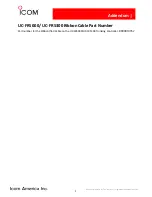
Feature Set Reference
102
025-9368H
Answer Type
When the Model 748 starts an interconnect call to a user (radio) on the channel, it must have a way
of knowing when the called party (user) has answered to connect the parties.
Answer type
sets this
parameter for each user (radio).
There are 3 ways to answer a call:
1)
“*” to answer, this is the default. The user keys his radio, encoding any required sub-audible
tone/code and sends a DTMF “*” for greater than 500 milliseconds.
2)
“PTT” to answer, The user keys his radio, encoding any required sub-audible tone/code. No
DTMF required here.
3)
“ANI” to answer, The user keys his radio, encoding any required sub-audible tone/code and
sends his Access ANI.
How to program it:
Access the Model 748 through your direct connected PC or terminal, or remotely from your PC
connected to a modem via the Model 748's internal modem.
Once connected to the Model 748 and the Main Menu is on the screen, type “1” and press
ENTER
,
and the Interconnect Menu will appear. Type “3” and press
ENTER
, the Interconnect User menu will
be displayed using the currently selected user's data. Select the User number you wish to program
(see “User Range” later in this section). Select the item number for
Answer type
followed by
ENTER
.
The currently selected mode or state will be shown along with a message instructing you to press the
space bar to change the mode or state, and to press
ENTER
to accept the current mode or state. Each
time the space bar is pressed, the mode or state changes. Once the mode or state you desire is
displayed, press
ENTER
to accept it. Note that if you accidentally pass the mode or state you want,
keep pressing the space bar and the Model 748 will wrap around (when the last choice is displayed,
it will return to the first one).
The default
Answer type
is “*” to answer for all users.
Answer type
is supported by block or range programming. See “User Range” later in this section for
details.
Summary of Contents for 748
Page 2: ......
Page 68: ...Operation 54 025 9368H Notes...
Page 110: ...Programming 96 025 9368H Notes...
Page 216: ...Feature Set Reference 202 025 9368H Notes...
Page 219: ...Repair 025 9368H 205 MODEL 7XX AUDIO BLOCK DIAGRAM 006 0077A...
Page 225: ...Repair 025 9368H 211 MODEL 7XX CONTROL BOARD 008 9793D Schematic Sheet 1 of 5...
Page 226: ...Repair 212 025 9368H MODEL 7XX CONTROL BOARD SCHEMATIC 008 9793D Sheet 2 of 5...
Page 227: ...Repair 025 9368H 213 MODEL 7XX CONTROL BOARD SCHEMATIC 008 9793D Sheet 3 of 5...
Page 228: ...Repair 214 025 9368H MODEL 7XX CONTROL BOARD SCHEMATIC 008 9793D Sheet 4 of 5...
Page 229: ...Repair 025 9368H 215 MODEL 7XX CONTROL BOARD SCHEMATIC 008 9793D Sheet 5 of 5...
Page 230: ...Repair 216 025 9368H MODEL 7XX CONTROL BOARD 702 9793D Silkscreen...
Page 233: ...Repair 025 9368H 219 MODEL 7XX SINGLE E E CARD 008 9794A Schematic...
Page 234: ...Repair 220 025 9368H MODEL 7XX SINGLE E E CARD 702 9794A Silkscreen...
Page 236: ...Repair 222 025 9368H MODEL 4XB VOICE CARD 008 9236F Schematic...
Page 237: ...Repair 025 9368H 223 MODEL 4XB VOICE CARD 702 9236F Silkscreen...
Page 239: ...Repair 025 9368H 225 MODEL 4XB DIAL CLICK BOARD 008 9242E Schematic...
Page 240: ...Repair 226 025 9368H MODEL 4XB DIAL CLICK BOARD 702 9242E Silkscreen...
Page 254: ...Quick Reference 240 025 9368H Notes...
Page 258: ...Specifications 244 025 9368H...
Page 259: ...Specifications 025 9368H 245...
















































